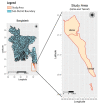Water, Sanitation, and Hygiene (WASH) Practices and Outreach Services in Settlements for Rohingya Population in Cox's Bazar, Bangladesh, 2018-2021
- PMID: 35954994
- PMCID: PMC9368108
- DOI: 10.3390/ijerph19159635
Water, Sanitation, and Hygiene (WASH) Practices and Outreach Services in Settlements for Rohingya Population in Cox's Bazar, Bangladesh, 2018-2021
Abstract
(1) Background: This study aimed to investigate the existing water, sanitation, and hygiene (WASH) policy and practice of the study population and strengthen the evidence base by documenting changes in the WASH policy and practice over 3 years of the Rohingya refugee humanitarian crisis, Cox's Bazar, Bangladesh. (2) Methods: A cross-sectional surveillance design was followed; the sampling of the study population included the Rohingya refugee population and neighborhood host nationals who required hospitalization soon after seeking care and enrolled into the diarrheal disease surveillance in diarrhea-treatment centers. Throughout the study period of 3 years, a total of 4550 hospitalized individuals constituted the study participants. (3) Results: Among the hospitalized Rohingya refugee population; the use of public tap water increased significantly from 38.5% in year 1 to 91% in year 3. The use of deep tube well water significantly changed from 31.3% to 8.2%, and the use of shallow tube well water reduced significantly from 25.8% to 0.4%. Households using water seal latrine were 13.3% in year 1 and increased significantly to 31.7% in year 3. ORS consumption at home changed significantly from 61.5% in the first year to 82.1% in third year. Multivariable analysis demonstrated patients' age groups at 5 to 14 years, and 15 years and more, drinking non-tube well water, soap use after using toilet, use of non-sanitary toilet facility, father's and mother's lack of schooling, and some and severe dehydration were significantly associated with the Rohingya refugee population enrolled into the diarrheal disease surveillance. (4) Conclusion: The findings indicate significant advances in WASH service delivery as well as outreach activities by aid agencies for the Rohingya refugee population living in settlements.
Keywords: Rohingya refugee population; WASH; case management; diarrheal disease; disease surveillance; emergency crisis settings.
Conflict of interest statement
The authors declare no conflict of interest. The funders had no role in the design of the study; in the collection, analyses, or interpretation of data; in the writing of the manuscript, or in the decision to publish the results.
Figures



References
-
- Ullah A.A. Rohingya Refugees to Bangladesh: Historical Exclusions and Contemporary Marginalization. J. Immigr. Refug. Stud. 2011;9:139–161. doi: 10.1080/15562948.2011.567149. - DOI
-
- Schmitt M.L., Wood O.R., Clatworthy D., Rashid S.F., Sommer M. Innovative strategies for providing menstruation-supportive water, sanitation and hygiene (WASH) facilities: Learning from refugee camps in Cox’s bazar, Bangladesh. Confl. Health. 2021;15:10. doi: 10.1186/s13031-021-00346-9. - DOI - PMC - PubMed
-
- Faruque A.S.G., Khan A.I., Islam S.M.R., Nahar B., Hossain M.N., Widiati Y., Hasan A.S.M.M., Prajapati M., Kim M., Vandenent M., et al. Diarrhea treatment center (DTC) based diarrheal disease surveillance in settlements in the wake of the mass influx of forcibly displaced Myanmar national (FDMN) in Cox’s Bazar, Bangladesh, 2018. PLoS ONE. 2021;16:e0254473. doi: 10.1371/journal.pone.0254473. - DOI - PMC - PubMed
-
- Bowden M., Crisp J. Special Feature Rohingya Refugees in Bangladesh: The Humanitarian Response. Humanit Pract Netw ODI. 2018. [(accessed on 3 July 2022)]. Available online: https://odihpn.org/wp-content/uploads/2018/10/HE-73_web.pdf.
Publication types
MeSH terms
Substances
LinkOut - more resources
Full Text Sources
Miscellaneous

